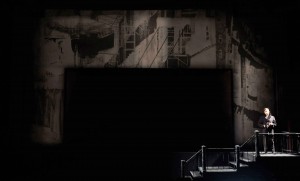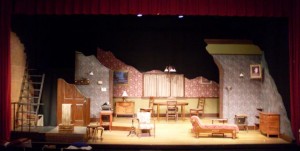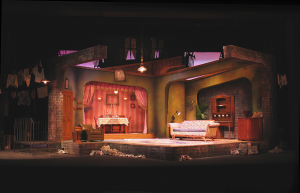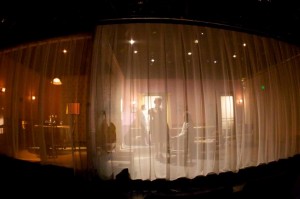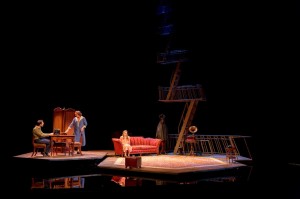Tennessee Williams calls The Glass Menagerie a “memory play,” and his specific instructions regarding the set design are included to enhance the concept of memory and how its fluid and dreamy nature influences the actions and dialogue of his characters. Below are selected set designs for The Glass Menagerie with some commentary on how they might be perceived in terms of Williams’s specifications.

These two designs from Junghyun Georgia Lee for the REP at the University of Delaware portray the fire escape motif and the Wingfield apartment. The scrim in the second photo softens the pattern of the wallpaper on the back wall of the dining room portion of the set.
This design by Ardean J. Landhuis hints at both the inconsistency of memory–note the walls that do not go all the way up–and the setting of the play (the shape at stage left resembles the state of Missouri).
This design from California State University Stanislaus emphasizes the exterior environment surrounding the apartment. Notice the details including the clotheslines, full fire escape, and trash swept against the foundation of the set.
Gauzy curtains mask the thrust stage of Theatreworks Colorado Springs’ production. Design by Julia Przedmojska.
This design by Bob Crowley for the 2013 Broadway revival starring Cherry Jones and Zachary Quinto was nominated for a Tony Award. “Crowley and [play director John] Tiffany…envisioned the Wingfield home floating inside black pools of memory, isolating the characters from the outside world. ‘When [the audience] walks in you just see these floating platforms and you see that they are sort of lost in time,’ he said. ‘It’s a family who are completely disconnected from the real world.’ In fact, the final design is so physically isolating that the actors can only enter the stage via trap doors below the floor.” (from “The Look of a Classic: How Tony-Winning Designer Bob Crowley Re-envisioned the Set for The Glass Menagerie” by Benjamin Solomon, Playbill, 08 Sep 2013)

